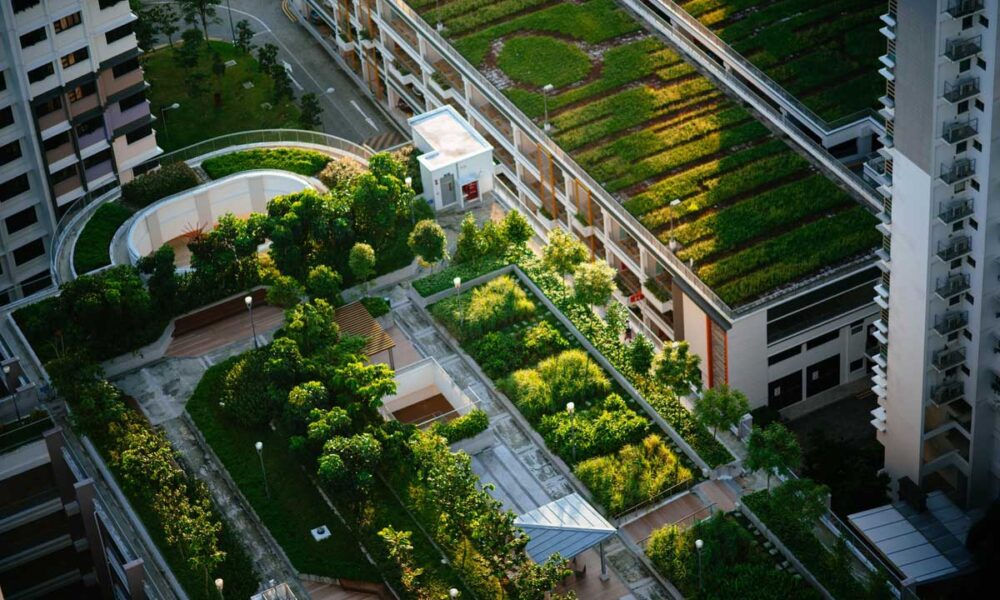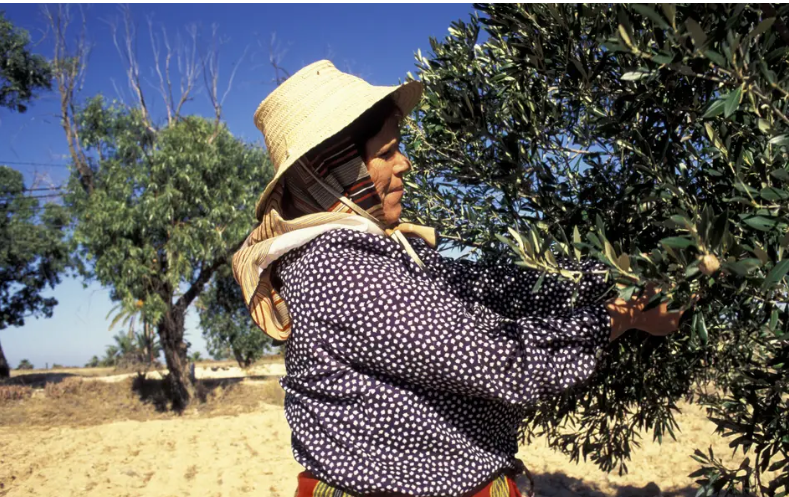BUSINESS & ECONOMY
Marine life is on the brink of extinction: Climate reality is a real issue
Published
2 years agoon
By
Editor
Nature has provided abundant resources and can be used into various processed products that can help ease human life. With the enormous potential of nature that is already available, it is the human task to utilize it and maintain the preservation and balance of nature so that it does not become extinct or lost due to excessive use without being accompanied by environmental conservation. One of the wealth that is widely available in nature is natural fiber. Natural fiber is a raw material used in the textile industry which can then be processed into various useful needs, not only into cloth, but many products actually require fiber as a raw material, one example is composites. Composites are generally made of powder or particles which are usually used to increase the strength of the material. However, in the era where technology began to develop, various composites derived from fiber. Fiber composites themselves are the same as composites in general, but the material used is not wood powder or particles but the main ingredient is fiber. So that the type of fiber greatly affects the strength of a composite made.
Generally, fiber comes from 2 sources, namely synthetic fiber and natural fiber. Natural fiber itself can come from animals and plants. Animal fibers such as wool, silk, alpaca, camel, etc. The highest content of animal fiber origin is protein. Then the fiber from plant can be further divided into several types according to its origin, fiber from seeds, stems and leaves. Fibers from seeds such as cotton and kapok, fibers from stems such as ramie and bamboo fibers, fibers from leaves such as pineapple and sisal leaf fibers. Chemically, all fiber derived from plants, the main element in the fiber is cellulose, although other elements in varying amounts are also contained in it, such as hemicellulose, lignin, pectin, ash (Hidayat, 2008).
The trend of using natural fiber to be processed into objects that have benefits and selling value continues to increase from year to year. This happens because many people have realized the importance of protecting the earth, so many have started to use materials that come from nature so that they can be decomposed and do not create waste that is difficult to decompose such as plastic, metal, and styrofoam. The trend of using sustainable materials is very positive and has a good impact in the long term. Because with increasing public awareness about the importance of protecting this aging earth, it can help protect nature and reduce the extinction of animals and plants.
Here are some examples of types of natural fibers and their unique characteristics.
Pineapple leaf fiber
Who would have thought if it turns out that pineapple leaves can be made into fiber that has a high selling value. Pineapple leaf fiber is fiber taken from pineapple leaves. The extraction of fiber from the leaves is carried out by a series of special processes. Pineapple leaves have an outer layer consisting of an upper and lower layer. Between these layers there are many bonds or strands of fibers that are bound to one another by a kind of gummy substance in the leaves. From the weight of fresh green pineapple leaves, approximately 2.5% to 3.5% of pineapple leaf fiber will be produced (Hidayat, 2008). The properties of this pineapple leaf fiber include being able to absorb moisture, its unique color because it has a whitish or silvery accent, it has a very high cellulose content, this fiber is quite strong and does not shrink easily, has antibacterial properties, has a distinctive smell and is shiny.
Hemp fiber
Is a fiber produced from the stems of the flax or flax plant. According to several sources, hemp fiber is one of the fibers that has been used for hundreds of years and is still being processed and utilized. Hemp fiber has a low lignin content, which makes this fiber have a white color. The characteristic properties of hemp fiber are its relatively long fiber, this fiber has better tensile strength than cotton, the absorption capacity of this fiber is quite high, and it has resistance to bacteria and fungi (Fitinline, 2020).
Bamboo Fiber
Is a type of fiber that is processed from the bamboo plant. There are many types of bamboo in this world but the most commonly used bamboo for processing into cloth is banbu moso (Phyllostachys edulis). The process of processing bamboo into fiber is quite complicated but it is comparable because it turns out that bamboo fiber has many advantages. Some of the characteristics of the properties of bamboo fiber include antibacterial and antifungal properties, even after washing it many times, these properties do not disappear but remain, can absorb and reduce odors, have a good absorption rate, and this fiber is very smooth and soft so it is suitable for several applications. people who have sensitive skin (Bamboo, 2016).
Sisal Fiber
Is a fiber that comes from the agave plant, types of agave cantala and agave sisalana. Agave itself is one of the unique types of plants because the stems and leaves are united and the fiber contained in the leaves is quite strong. Sisal fiber itself has the characteristics of hard, rough, very strong and yellowish white. Sisal fiber has many functions that can be used, among others, for textiles, geotextiles, car body reinforcement, crafts, building and construction materials, etc. One sisal plant produces about 200-250 leaves and one leaf contains 1000-1200 fiber bundles(Basuki, 2017).
Abaka Fiber
Is a fiber derived from the leaves of the abaca plant (Musa Textilis) including the family of Musaceae or types of bananas. Abaca fiber has the characteristics of being strong, waterproof, flexible and has good buoyancy. Because of these advantages, this fiber is widely used for the production of ropes and nets, which can also be used for making clothes. As well as raw materials for making filter paper, stencil paper to paper that requires high durability and storage power such as banknotes, securities, document paper, map paper, and other commercial products. Abaca fiber is used as a material for making currency because it has the advantages of fiber, including having the strength not brittle and not easy to break, having a very good texture, shiny like reflecting light, durable, flexible, and resistant to salinity (Balittas R & D agriculture, nd).
Each natural fiber has its own advantages and uniqueness. It is estimated that in the future the use of natural fibers will continue to increase considering the various human needs that are increasing from year to year and increasingly sophisticated technology does not rule out the possibility that in the future the use of natural fibers can be more optimal than now. However, to achieve this, we need to protect and preserve nature and protect the earth so that natural fibers can still grow and not experience extinction or scarcity.
Related
You may like
-


WEF and UN-Habitat Join Forces to Unlock Critical Investment in Cities through Public-Private Collaboration
-


5 ways countries can adapt to the climate crisis
-


The Development of Artificial Intelligence in China: Conclusions
-


Four ways the planetary crisis is impacting mental health
-


New European Bauhaus under Cohesion Policy: €50 million call for innovative projects in cities
-


The Development of Artificial Intelligence in China: Investment and attention to production
BUSINESS & ECONOMY
In Times of Conflict, Spare a Thought for the Non-Gulf Economies
Published
6 days agoon
May 6, 2024By
Editor
By James Swanston
Positive news for non-GCC Arab economies has been in short supply of late. The Gaza conflict, missile attacks in the Red Sea, war in Ukraine and last month’s tit-for-tat missile strikes between Israel and Iran have weighed on sentiment, undermined limited confidence and cut into growth.
But some positives have emerged. Headline inflation rates have slowed across much of North Africa and the Levant, implying lower interest rates, a return to real growth and more stable exchange rates. March data show inflation at an annualised rate of just 0.9 percent in Morocco and 1.6 percent in Jordan. Tunisia’s inflation rate has also come down, although it is still running at over 7 percent year on year.
Egypt’s inflation rate jumped earlier this year as the government implemented price hikes to some goods and services – notably fuel. In February, the effect of the devaluation in the pound to the level of the parallel market affected prices. But March’s reading eased to an albeit still high 33 percent year on year.
Elsewhere, Lebanon’s inflation slowed to 70 percent year on year in March, the first time it has been in double – rather than triple – digits since early 2020 due to de-facto dollarisation and lower demand for imports. That said, inflation in these economies is vulnerable to increases in the prices of global foods and energy (such as oil) due to their being net importers. If supply chain disruptions persist, it could result in central banks keeping monetary policy tighter with consequences for growth and employment. And in Morocco’s case, it could undermine the Bank Al-Maghrib’s intention to widen the dirham’s trading band and formally adopt an inflation-targeting monetary framework.
The strikes by Iran and Israel undoubtedly marked a dangerous escalation in what up to now had been a proxy war. Thankfully, policymakers across the globe have for the moment worked to de-escalate the situation. Outside the countries directly involved, the most significant spillover has been the disruptions to shipping in the Red Sea and Suez Canal. Many of the major global shipping companies have diverted ships away from the Red Sea due to attacks by Houthi rebels and have instead opted to go around the Cape of Good Hope.
The latest data shows that total freight traffic through the Suez Canal and Bab el-Mandeb Strait is down 60-75 percent since the onset of the hostilities in Gaza in early October. Almost all countries have seen fewer port calls. This could create fresh shortages of some goods imports, hamper production, and put upward pressure on prices.
For Egypt, inflation aside, the shipping disruptions have proven to be a major economic headache. Receipts from the Suez Canal were worth around 2.5 percent of GDP in 2023 – and that was before canal fees were hiked by 15 percent this January. Canal receipts are a major source of hard currency for Egypt and officials have said that revenues are down 40-50 percent compared to levels in early October.
The conflict is also weighing on the crucial tourism sector. Tourism accounts for 5-10 percent of GDP in the economies of North Africa and the Levant and is a critical source of hard currency inflows.
Jordan, where figures are the timeliest, show that tourist arrivals were down over 10 percent year on year between November and January. News of Iranian drones and missiles flying over Jordan imply that these numbers will, unfortunately, have fallen further.
In the case of Egypt, foreign currency revenues – from tourism and the Suez canal – represent more than 6 percent of GDP and are vulnerable. This played a large part in the decision to de-value the pound and hike interest rates aggressively in March.
The saving grace is that the conflict has galvanised geopolitical support for these economies. For Egypt, the aforementioned policy shift was accompanied by an enhanced $8bn IMF deal and, while not strictly bilateral support, the bumper Ras el-Hekma deal seems to have been accelerated as the pressure on the Egyptian economy ratcheted up. This is providing much needed foreign currency. At the same time, Jordan recently renewed its financing arrangement with the IMF for $1.2bn over four years.
Tunisia, however, is an exception. President Saied’s anti-IMF rhetoric and reluctance to pass reforms, such as harsh fiscal consolidation, in an election year, mean that the country’s staff-level agreement for an IMF deal is likely to remain in limbo. If strains on Tunisia’s foreign receipts are stretched, and the central bank and government continue with unorthodox policies of deficit financing, there is a risk that Tunisia’s economic crisis will become messier more quickly in the next year – particularly large sovereign debt repayments are due in early 2025.
James Swanston is Middle East and North Africa economist at London-based Capital Economics
BUSINESS & ECONOMY
Debt Dependency in Africa: the Drivers
Published
6 days agoon
May 6, 2024By
Editor
In mid-April Ghana’s efforts to restructure its sovereign debt came to nothing, increasing the risk that it couldn’t keep up with its repayments. This is a familiar story for many African countries. Twenty of them are in serious debt trouble. Carlos Lopes argues that there are three factors driving this state of affairs: the rules of the international banking system; lenders’ focus on poverty reduction rather than development needs; and unfair treatment by rating agencies.
The debt situation in many African countries has escalated again to a critical juncture. Twenty are in, or at risk of, debt distress. Three pivotal elements significantly contribute to this. Firstly, the rules governing the international banking system favour developed countries and work against the interests of African countries.
Secondly, multilateral financial institutions such as the International Monetary Fund (IMF) and the World Bank focus on poverty alleviation. This is commendable. But it doesn’t address the liquidity crisis countries face. Many don’t have the necessary readily available funds in their coffers to cover urgent development priorities due to their dependency on volatile commodity exports. As a result governments turn to raising sovereign debt under conditions that are among the most unfavourable on the planet. This perpetuates a debt dependency cycle rather than fostering sustainable economic growth.
Thirdly, there’s the significant influence of biased credit rating agencies. These unfairly penalise African countries. In turn, this impedes their ability to attract investment on favourable terms. The convergence of these three factors underscores the imperative to implement effective strategies aimed at mitigating the overwhelming debt burden afflicting African nations. These strategies must address the immediate financial challenges facing countries. They must also lay the groundwork for long-term economic sustainability and equitable development across the continent.
By tackling these issues head-on, a financial environment can be created that fosters growth, empowers local economies, and ensures that African countries have access to the resources they need to thrive.
Rules of the banking game
The Bank for International Settlements is often called the “central bank for central banks”. It sets the regulations and standards for the global banking system. But its rules disproportionately favour developed economies, leading to unfavourable conditions for African countries. For instance, capital adequacy requirements – the amount of money banks must hold in relation to their assets – and other prudential rules may be disproportionately stringent for African markets. This limits lending to stimulate economic growth in less attractive economies.
The bank’s policies also often overlook developing nations’ unique challenges. Following the 2008/2009 financial crisis, the bank introduced a new, tougher set of regulations. Their complexity and stringent requirements have inadvertently accelerated the withdrawal of international banks from Africa.
They have also made it increasingly difficult for global banks to operate profitably in African markets. As a result, many have chosen to scale back their operations, or exit. The withdrawals have reduced competition within the banking sector, limited access to credit for businesses and individuals, and hampered efforts to promote economic growth and development.
The limitations of the new regulations highlight the need for a more nuanced approach to banking regulation. The adverse effects could be mitigated by simplifying the regulations. For example, requirements could be tailored to the specific needs of African economies, and supporting local banks.
Focus on poverty alleviation
Multilateral financial institutions like the IMF and the World Bank play a crucial role in providing financial assistance to many countries on the continent. But their emphasis on poverty alleviation and, more recently, climate finance often overlooks the urgent spending needs. Additionally, the liquidity squeeze facing countries further limits their capacity to prioritise essential expenditure. Wealthy nations enjoy the luxury of lenient regulatory frameworks and ample fiscal space. For their part African countries are left to fend for themselves in an environment rife with predatory lending practices and exploitative economic policies. Among these are sweetheart tax deals which often involving tax exemptions. In addition, illicit financial practices by multinational corporations drain countries of their limited resources. Research by The ONE Campaign found that financial transfers to developing nations plummeted from a peak of US$225 billion in 2014 to just US$51 billion in 2022, the latest year for which data is available. These flows are projected to diminish further.
Alarmingly, the ONE Campaign report stated that more than one in five emerging markets and developing countries allocated more resources to debt servicing in 2022 than they received in external financing. Aid donors have been touting record global aid figures. But nearly one in five aid dollars was directed towards domestic spending hosting migrants or supporting Ukraine. Aid to Africa has stagnated.
This leaves African countries looking for any opportunities to access liquidity, which makes them a prey of debt scavengers. As noted by Columbia University professor José Antonio Ocampo, the Paris Club, the oldest debt-restructuring mechanism still in operation, exclusively addresses sovereign debt owed to its 22 members, primarily OECD countries.
With these limited attempts to address a significant structural problem of pervasive indebtedness it is unfair to stigmatise Africa as if it contracted debt because of its performance or bad management.
Rating agencies
Rating agencies wield significant influence in the global financial landscape. They shape investor sentiment and determine countries’ borrowing costs. However, their assessments are often marked by bias. This is particularly evident in their treatment of African countries. African nations argue that without bias, they should receive higher ratings and lower borrowing costs. In turn this would mean brighter economic prospects as there is a positive correlation between financial development and credit ratings. However, the subjective nature of the assessment system inflates the perception of investment risk in Africa beyond the actual risk of default. This increases the cost of credit.
Some countries have contested ratings. For instance, Zambia rejected Moody’s downgrade in 2015, Namibia appealed a junk status downgrade in 2017 and Tanzania appealed against inaccurate ratings in 2018. Ghana contested ratings by Fitch and Moody’s in 2022, arguing they did not reflect the country’s risk factors. Nigeria and Kenya rejected Moody’s rating downgrades. Both cited a lack of understanding of the domestic environment by rating agencies. They asserted that their fiscal situations and debt were less dire than estimated by Moody’s.
Recent arguments from the Economic Commission for Africa and the African Peer Review Mechanism highlight deteriorating sovereign credit ratings in Africa despite some posting growth patterns above 5% for sustained periods. Their joint report identifies challenges during the rating agencies’ reviews. This includes errors in publishing ratings and commentaries and the location of analysts outside Africa to circumvent regulatory compliance, fees and tax obligations.
A recent UNDP report illuminates a staggering reality: African nations would gain a significant boost in sovereign credit financing if credit ratings were grounded more in economic fundamentals and less in subjective assessments. According to the report’s findings, African countries could access an additional US$31 billion in new financing while saving nearly US$14.2 billion in total interest costs.
These figures might seem modest in the eyes of large investment firms. But they hold immense significance for African economies. If credit ratings accurately reflected economic realities, the 13 countries studied could unlock an extra US$45 billion in funds. This is equivalent to the entire net official development assistance received by sub-Saharan Africa in 2021. These figures underscore the urgent need to address the systemic biases plaguing credit rating assessments in Africa.
Next steps
Debates about Africa’s debt crisis often lean towards solutions centered on compensation. These advocate for increased official development aid, more generous climate finance measures, or the reduction of borrowing costs through hybrid arrangements backed by international financial systems. These measures may offer temporary relief. But they need to be more genuine solutions in light of the three structural challenges facing African countries.
Carlos Lopes,a Professor at the Nelson Mandela School of Public Governance, University of Cape Town, is the Chair of the African Climate Foundation’s Advisory Council as well as its Chairman of the Board. He is also a board member of the World Resources Institute and Climate Works Foundation.
Courtesy: The Conversation
BUSINESS & ECONOMY
IsDB President Advocates for Cultivating Entrepreneurial Leaders
Published
2 weeks agoon
April 30, 2024By
Editor
By Hafiz M. Ahmed
The 18th Global Islamic Finance Forum recently served as a prominent platform for discussions on advancing Islamic finance and fostering leadership in the entrepreneurial sector. During this notable event, the President of the Islamic Development Bank (IsDB) emphasized the critical need for nurturing entrepreneurial leaders to propel the growth of the Islamic finance industry. This blog post explores the insights shared by the IsDB President, the implications for the future of Islamic finance, and the strategies proposed to develop the next generation of leaders.
Key Highlights from the Forum
The Global Islamic Finance Forum, held annually, brings together experts, policymakers, and stakeholders from across the world to deliberate on the challenges and opportunities within Islamic finance. This year’s focus on entrepreneurial leadership underscores the sector’s evolution and its growing impact on global economies.
The IsDB President’s Vision
- Empowering Entrepreneurs. The IsDB President outlined a vision where empowerment and support for entrepreneurs are paramount. He highlighted the role of Islamic finance in providing ethical and sustainable funding options that align with the principles of Sharia law, offering a robust alternative to conventional financing methods.
- Education and Training. A significant part of the address was dedicated to the importance of education and specialized training in Islamic finance. The President called for enhanced educational programs that not only focus on the technical aspects of Islamic finance but also foster entrepreneurial thinking and leadership skills among students.
- Innovation in Financial Products. Recognizing the rapidly changing financial landscape, the call for innovation in designing financial products that meet the unique needs of modern businesses was emphasized. These innovations should aim to enhance accessibility, affordability, and suitability for diverse entrepreneurial ventures.
- Collaborative Efforts. The IsDB President advocated for increased collaboration between Islamic financial institutions and educational entities to create ecosystems that support and nurture future leaders. This collaboration is essential for developing a holistic environment where aspiring entrepreneurs can thrive.
- Supportive Policies: Lastly, the need for supportive governmental policies that facilitate the growth of Islamic finance was discussed. Such policies should encourage entrepreneurship, particularly in regions where access to financial services is limited.
Implications for the Future
The advocacy for entrepreneurial leaders in Islamic finance is timely, as the industry sees exponential growth and wider acceptance as a viable financial system globally. Cultivating leaders who not only understand the intricacies of Islamic finance but who are also capable of innovative thinking and ethical leadership is crucial for the sustainability and expansion of this sector.
Steps Forward
- Integrating Leadership into Curriculum: Educational institutions offering courses in Islamic finance should integrate leadership training into their curricula.
- Mentorship Programs: Establishing mentorship programs that connect experienced professionals in Islamic finance with emerging leaders.
- Fostering Start-up Ecosystems: Creating supportive environments for start-ups within the Islamic financial framework can encourage practical learning and innovation.
Conclusion
The call by the IsDB President to nurture entrepreneurial leaders in Islamic finance is a step toward ensuring the sector’s robust growth and its contribution to global economic stability. By focusing on education, innovation, and supportive policies, the Islamic finance industry can look forward to a generation of leaders who are well-equipped to navigate the complexities of the modern financial world and who are committed to ethical and sustainable business practices. This vision not only enhances the profile of Islamic finance but also contributes to a more inclusive and balanced global financial ecosystem.

Turkey’s Bold Stand Against Israeli Aggression in Gaza: A Call for Global Solidarity

What is Microtakaful and How Does It Work?

Top 8 Ways Halal Cosmetics Are Reshaping Fashion in 2024
Topics
- AGRIBUSINESS & AGRICULTURE
- BUSINESS & ECONOMY
- DIGITAL ECONOMY & TECHNOLOGY
- EDITORIAL
- ENERGY
- EVENTS & ANNOUNCEMENTS
- HALAL ECONOMY
- HEALTH & EDUCATION
- IN CASE YOU MISSED IT
- INTERNATIONAL POLITICS
- ISLAMIC FINANCE & CAPITAL MARKETS
- KNOWLEDGE CENTRE, CULTURE & INTERVIEWS
- OBITUARY
- OPINION
- PROFILE
- PUBLICATIONS
- SPECIAL FEATURES/ECONOMIC FOOTPRINTS
- SPECIAL REPORTS
- SUSTAINABILITY & CLIMATE CHANGE
- THIS WEEK'S TOP STORIES
- TRENDING
- UNCATEGORIZED
- UNITED NATIONS SDGS
Trending
-

 TRENDING11 months ago
TRENDING11 months agoAFRIEF Congratulates New Zamfara State Governor
-

 PROFILE9 months ago
PROFILE9 months agoA Salutary Tribute to General Ibrahim Badamasi Babangida: Architect of Islamic Finance in Nigeria
-

 BUSINESS & ECONOMY3 years ago
BUSINESS & ECONOMY3 years agoClimate Policy In Indonesia: An Unending Progress For The Future Generation
-

 BUSINESS & ECONOMY3 years ago
BUSINESS & ECONOMY3 years agoThe Climate Crisis is Now ‘Code Red’: We Can’t Afford to Wait Any Longer
-

 BUSINESS & ECONOMY3 years ago
BUSINESS & ECONOMY3 years agoIPCC report: ‘Code red’ for human driven global heating
-

 HALAL ECONOMY10 months ago
HALAL ECONOMY10 months agoRevolutionizing Halal Education Through Technology
-

 SPECIAL REPORTS5 months ago
SPECIAL REPORTS5 months agoRemembering Maryam Ibrahim Babangida: A Legacy of Grace, Philanthropy, and Leadership
-

 BUSINESS & ECONOMY2 years ago
BUSINESS & ECONOMY2 years agoDistributed Infrastructure: A Solution to Africa’s Urbanization

